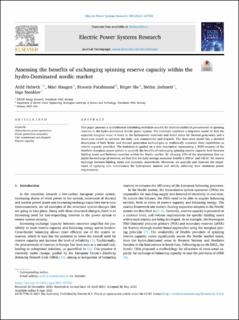| dc.contributor.author | Helseth, Arild | |
| dc.contributor.author | Haugen, Mari | |
| dc.contributor.author | Farahmand, Hossein | |
| dc.contributor.author | Mo, Birger | |
| dc.contributor.author | Jaehnert, Stefan | |
| dc.contributor.author | Stenkløv, Inge | |
| dc.date.accessioned | 2021-09-20T11:53:04Z | |
| dc.date.available | 2021-09-20T11:53:04Z | |
| dc.date.created | 2021-06-24T19:56:54Z | |
| dc.date.issued | 2021 | |
| dc.identifier.citation | Electric power systems research. 2021, 199, 1-9. | en_US |
| dc.identifier.issn | 0378-7796 | |
| dc.identifier.uri | https://hdl.handle.net/11250/2779197 | |
| dc.description.abstract | This paper presents a hydrothermal scheduling toolchain suitable for detailed studies of procurement of spinning reserves in the hydro-dominated Nordic power system. The toolchain combines a long-term model to find the expected marginal value of water in the hydropower reservoirs and initial states for thermal generators, and a short-term model to optimize the daily unit commitment and dispatch. The short-term model has a detailed description of both hydro and thermal generation technologies to realistically constrain their capabilities as reserve capacity providers. The toolchain is applied on a data description representing a 2030 scenario of the Northern European power system to quantify the benefits of exchanging spinning reserve capacity both between bidding zones and between countries within the Nordic market. By allowing 10% of the transmission line capacity for exchange of reserves, we find that the daily average economic benefit is 290 k€ and 102 k€ for reserve exchange between bidding zones and countries, respectively. Moreover, we quantify and illustrate the importance of applying unit commitment for hydropower stations and strictly enforcing their minimum power requirements. | en_US |
| dc.language.iso | eng | en_US |
| dc.publisher | Elsevier Science | en_US |
| dc.rights | Navngivelse 4.0 Internasjonal | * |
| dc.rights.uri | http://creativecommons.org/licenses/by/4.0/deed.no | * |
| dc.title | Assessing the benefits of exchanging spinning reserve capacity within the hydro-Dominated nordic market | en_US |
| dc.type | Peer reviewed | en_US |
| dc.type | Journal article | en_US |
| dc.description.version | publishedVersion | en_US |
| dc.source.pagenumber | 1-9 | en_US |
| dc.source.volume | 199 | en_US |
| dc.source.journal | Electric power systems research | en_US |
| dc.identifier.doi | 10.1016/j.epsr.2021.107393 | |
| dc.identifier.cristin | 1918288 | |
| dc.relation.project | Norges forskningsråd: 268014 | en_US |
| dc.source.articlenumber | 107393 | en_US |
| cristin.ispublished | true | |
| cristin.fulltext | original | |
| cristin.qualitycode | 1 | |

